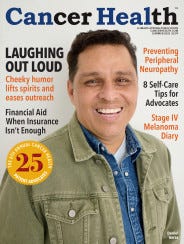The 2025 Cancer Health 25: A Salute to Patient Advocates—including The Active Surveillor of all people
Happy Father's Day.
By Howard Wolinsky
Cancer Health Magazine provides information and resources for individuals affected by cancer, including patients, their families, and their caregivers.
Their June issue featuring “The Cancer Health 25,” “salutes patient advocates for their unwavering efforts to support the cancer community. To be clear, our Cancer Health 25 is not a ‘best of’ list’ or a ‘most important’ ranking. In fact, 25 spots aren’t enough to enumerate the different ways people advocate for those affected by cancer. What we aim to do, however, is highlight—and thank!—a sampling of outstanding patient advocates.”
I am honored to be included on that list and see myself as a representative of my colleagues and friends in the “reluctant brotherhood” of prostate cancer patients and their supporters.
These people come from support and education groups I co-founded with Thrainn Thorvaldsson, Mark Lichty, Gene Slattery, and Bill Manning from Active Surveillance Patients International, Rick Davis at AnCan and others such as Alex Scholz of he tProstate Cancer Research Institute and Jim Schraidt at ZERO Prostate Cancer (formerly Us, TOO, and Mike Scott, forunder Prostate Cancer International and an early advocate for Active Surveillance, who saw something in me and persuaded me to become a voice for patients on Active Surveillance.
I am the veteran journalist who became an accidental advocate.
As a patient, I saw that other patients were not getting all the facts about Active Surveillance. Only 6-10% of men with low-risk prostate cancer were on AS, saving themselves from unnecessary treatment that could cause impotence, incontinence and other side effects.
I started mini-blogging about the situation on then-new Facebook, and I was getting calls from friends, their husbands, fathers, cousins and their friends asking about what was AS. Doctors were not sharing the information—because they didn’t know or didn’t trust what little information was available.
I began writing a column for MedPageToday.com focused on AS and low-risk prostate cancer at the request of an old friend, who was a founding editor and a Facebook lurker.
My columns revealed other needs in the AS community. This led me to be an advocate for men with low-risk PCa. I helped start two support and education for these men who were the orphans and Rodney Dangerfields of care and research.
A sea change came to our care. Patients made a leap of faith that they didn’t have to undergo aggressive treatment—though the studies were available to back that decision,
Minds were changed one by one in the urology community as research increasingly showed the value and safety of AS and older AS-resistant docs went into the sunset. As of 2022, 60% of us in the U.S. follow active surveillance.
It has been a remarkable achievement. But we haven’t done enough. 40% of us still choose aggressive treatment because we, our spouses, families and doctors don’t buy into the idea that we can co-exist with our usually benign cancers.
Contrast the 95% uptake of AS in United Kingdom and Sweden.
I didn’t get into this to win kudos or accolades—though I appreciate them as a means of promoting la causa. My goal has been to increase awareness. Hence, I co-founded support groups, only for men on AS hold monthly webinars with top experts in prostate cancer for ASPI, organized with other support groups in North America the production of the “Active Surveillance 101” series to help newbies learn the ropes of AS , and am now involved in rolling out new CaveMan small-format virtual support groups of 8-10 for low risk men in North America and internationally, and an in-person group locally called the Chicago Area Active Surveillors.
I can see a new generation of AS patients stepping up and leading this revolution into the future.
Who says men don’t care about their health?
Here’s my Cancer Health 25 listing:
Cracking the code on pathology reports: Helping patients navigate medicalese and getting better care
By Howard Wolinsky
The next webinar from Active Surveillance Patients International will be touching on how many patients don’t understand pathology reports or even Gleason scores—and what can be done about it,
So come, please, and maybe share your experience with pathology reports and medicalese.
Cathryn J. Lapedis, MD, MPH, a Clinical Assistant Professor of Pathology at Michigan Medicine in Ann Arbor, has found in her research that patient-centered reports can help patients understand the reports.
She will be the featured speaker at the ASPI webinar from noon to 1:30 p.m. on Saturday, June 28.
Please register for the meeting here.
Lapedis was the lead author of a recent study in JAMA that found a 93% comprehension of patient-centered pathology reports compared with 39% of those who read a report from the University of Michigan and 56% reading a pathology report from the Veterans Administration.
While 93% of participants who received the PCPR accurately identified that the report showed prostate cancer, only 39% of those who received the university report and 56% of those who received the VA report did so.
She also looked at how these patients interpreted Gleason scores: 84% reading specially prepared patient-centric reports understood their scores vs 48% for the university group and 40% for the VA group.
She has fellowship training in medical renal and gastrointestinal pathology. Her research centers on rethinking the way pathology results are communicated to patients and the healthcare system. She completed an in-depth analysis of key stakeholders’ attitudes towards patient-pathologist interactions, and is currently piloting early interventions in patient-centered pathology communications.
Please send questions in advance to: contactus@aspatients.org






Congratulations Mr. Wolinsky...thanks for all that you have done and will continue to do!
Thank you for all the work you do!